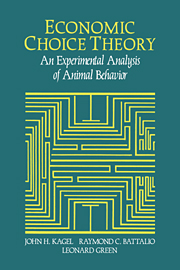Book contents
- Frontmatter
- Contents
- Preface
- Chapter 1 Introduction
- Chapter 2 Commodity-choice behavior I: Some initial tests of the theory
- Chapter 3 Commodity-choice behavior II: Tests of competing motivational processes and the representative consumer hypothesis
- Chapter 4 Labor-supply behavior I: Initial tests of the theory with some public policy implications
- Chapter 5 Labor-supply behavior II: Tests of competing motivational processes and earnings distributions for animal workers
- Chapter 6 Choices over uncertain outcomes
- Chapter 7 Intertemporal choice
- Chapter 8 Summing up
- Bibliography
- Index
Chapter 8 - Summing up
Published online by Cambridge University Press: 22 March 2010
- Frontmatter
- Contents
- Preface
- Chapter 1 Introduction
- Chapter 2 Commodity-choice behavior I: Some initial tests of the theory
- Chapter 3 Commodity-choice behavior II: Tests of competing motivational processes and the representative consumer hypothesis
- Chapter 4 Labor-supply behavior I: Initial tests of the theory with some public policy implications
- Chapter 5 Labor-supply behavior II: Tests of competing motivational processes and earnings distributions for animal workers
- Chapter 6 Choices over uncertain outcomes
- Chapter 7 Intertemporal choice
- Chapter 8 Summing up
- Bibliography
- Index
Summary
This chapter summarizes our applications of individual choice theory from economics to the study of animal behavior. Our research program has been guided by three primary goals. First and foremost, our goal has been to investigate experimentally important implications of economic choice theory using real, highly valued payoffs. By studying the behavior of individual subjects under rigorous experimental methods, we have been able to investigate economic choice theory without having to rely on the string of auxiliary assumptions usually required when using field data (assumptions about functional forms, measurement of variables, etc., which are often of questionable validity; see, for example, Pencavel, 1986). Our second goal has been to test between the different explanations of the data. This has led to an extensive dialogue, published primarily in psychology journals, in which economic choice theory has been contested with the matching law, a prominent model of choice in the animal psychology literature. Our third goal has been to shed some light on important and complex social issues, such as the cycle of poverty and characteristics of earnings distributions. Here we have used the unique advantages of experiments and the animal model to manipulate treatment variables (such as income level) which cannot easily be done (or are prohibitively expensive to do) with volunteer human subjects. In addition, we have focused on a few select variables – such as pure wealth effects in the cycle of poverty.
- Type
- Chapter
- Information
- Economic Choice TheoryAn Experimental Analysis of Animal Behavior, pp. 200 - 206Publisher: Cambridge University PressPrint publication year: 1995



